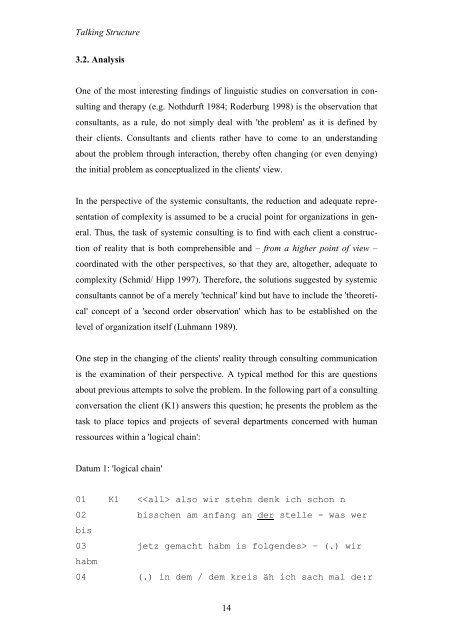In organisation theory, bridging the gap between „micro“ and „macro ...
In organisation theory, bridging the gap between „micro“ and „macro ...
In organisation theory, bridging the gap between „micro“ and „macro ...
Create successful ePaper yourself
Turn your PDF publications into a flip-book with our unique Google optimized e-Paper software.
Talking Structure<br />
3.2. Analysis<br />
One of <strong>the</strong> most interesting findings of linguistic studies on conversation in con-<br />
sulting <strong>and</strong> <strong>the</strong>rapy (e.g. Nothdurft 1984; Roderburg 1998) is <strong>the</strong> observation that<br />
consultants, as a rule, do not simply deal with '<strong>the</strong> problem' as it is defined by<br />
<strong>the</strong>ir clients. Consultants <strong>and</strong> clients ra<strong>the</strong>r have to come to an underst<strong>and</strong>ing<br />
about <strong>the</strong> problem through interaction, <strong>the</strong>reby often changing (or even denying)<br />
<strong>the</strong> initial problem as conceptualized in <strong>the</strong> clients' view.<br />
<strong>In</strong> <strong>the</strong> perspective of <strong>the</strong> systemic consultants, <strong>the</strong> reduction <strong>and</strong> adequate repre-<br />
sentation of complexity is assumed to be a crucial point for organizations in gen-<br />
eral. Thus, <strong>the</strong> task of systemic consulting is to find with each client a construc-<br />
tion of reality that is both comprehensible <strong>and</strong> – from a higher point of view –<br />
coordinated with <strong>the</strong> o<strong>the</strong>r perspectives, so that <strong>the</strong>y are, altoge<strong>the</strong>r, adequate to<br />
complexity (Schmid/ Hipp 1997). Therefore, <strong>the</strong> solutions suggested by systemic<br />
consultants cannot be of a merely 'technical' kind but have to include <strong>the</strong> '<strong>the</strong>oreti-<br />
cal' concept of a 'second order observation' which has to be established on <strong>the</strong><br />
level of organization itself (Luhmann 1989).<br />
One step in <strong>the</strong> changing of <strong>the</strong> clients' reality through consulting communication<br />
is <strong>the</strong> examination of <strong>the</strong>ir perspective. A typical method for this are questions<br />
about previous attempts to solve <strong>the</strong> problem. <strong>In</strong> <strong>the</strong> following part of a consulting<br />
conversation <strong>the</strong> client (K1) answers this question; he presents <strong>the</strong> problem as <strong>the</strong><br />
task to place topics <strong>and</strong> projects of several departments concerned with human<br />
ressources within a 'logical chain':<br />
Datum 1: 'logical chain'<br />
01 K1 – (.) wir<br />
habm<br />
04 (.) in dem / dem kreis äh ich sach mal de:r<br />
14














